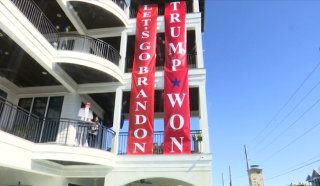|
Article Courtesy of ZERO
HEDGE
By Jonathan Turley
Published November 8, 2021
|
There is an interesting constitutional fight brewing in Florida.
I have a column out today on the “Let’s Go, Brandon” movement.
Marvin Peavy is part of that movement and displayed a banner with the chant
(with a pro Trump banner) from his home in Seagrove Beach, Florida.
|
Hanging from Peavy’s
home is a banner proclaiming “Trump Won” and another
proclaiming “Let’s Go Brandon.” The latter chant is a
euphemism for “F— Joe Biden.”
“I’m here on the beach, and I got a lot of traffic, and
people needed to see what I believe in,” Peavy said.
“That’s free speech, and I wanted everyone to know that I’m
a republican and I’m supporting Donald Trump.”
He is now facing a $50 a day fine for violating an ordinance
against such banners.
He has pledged to
continue to fight the enforcement. |
|
|
The question is whether the ordinance is constitutional.
The code states that following signs are “the prohibited in the Route 30-A
Scenic Corridor”:
B. Prohibited signs. In addition to the signs prohibited in Section 6.03.00, the
following signs shall be prohibited in the Route 30-A Scenic Corridor:
-
Permanent off-premise outdoor advertising signs (an
off-premise sign is any sign located on property other than that to which
the sign relates);
-
Pole signs;
-
Water towers as commercial advertising;
-
Wall murals as commercial advertising;
-
Off-premise signs;
-
Temporary mobile or portable signs;
-
Interior lit single panel plastic or Lexan face;
-
Streamers, feather flags, pennants, ribbons, spinners and
other similar devices;
-
Flashing signs;
-
Signs containing reflective elements that sparkle or
twinkle in the sunlight;
-
Roof signs;
-
Signs containing moving parts.
The law is notably neutral on content. That is a key distinction given prior
Supreme Court rulings like Reed v Town of Gilbert. In that case, the court ruled
unanimously that an Arizona ordinance was unconstitutional. Under the ordinance,
“ideological signs” and “political signs” were subject to different limitations.
Writing for the Court in Reed, Justice Clarence Thomas stressed that
“[g]overnment regulation of speech is content based if a law applies to
particular speech because of the topic discussed or the idea or message
expressed.”
The content-based regulation triggered “strict scrutiny” analysis requiring that
the government must demonstrate that the law has been “narrowly tailored” to
serve a “compelling interest.”
Here all signs are limited or banned in this area regardless of their message.
What remains, however, is the denial of homeowners to be able to speak
politically through signage on their own homes. The city would argue that they
can still speak in other ways. Moreover, there is a general exemption in the
ordinance for
“Temporary signs for political candidacy, nonprofit organizations, religious
institutions and other signs conveying a non-commercial message for a one-time
event provided that such signs are removed within 15 days following the
campaign, drive, or event.”
Again, there is no content regulation here and political signs are allowed
during campaign seasons.
But how about those who want to express political views between elections? Such
sentiments are supporting ongoing movements, including “Let’s Go Brandon” which
is a criticism of media bias. This is an aesthetic regulation that negates forms
of political expression. While the odds may be against Peavy, he may force a
reconsideration of such speech rights. |
